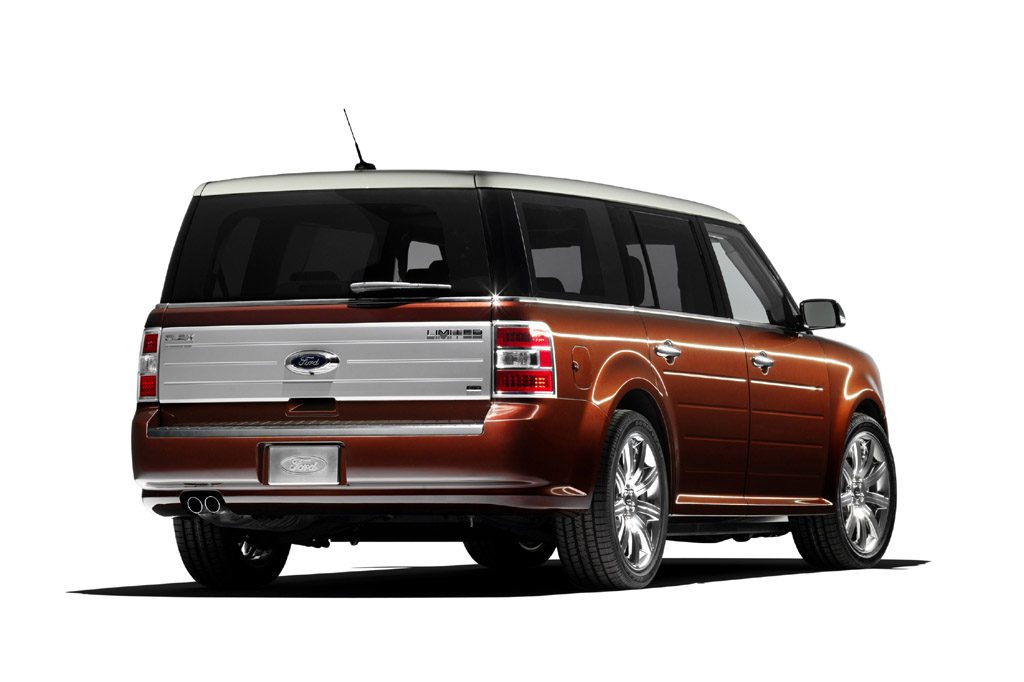| Midsize SUV; Built in Canada |
|
|
| Good condition price range: $7,100 – $30,000* |

2009 Ford Flex Front

2009 Ford Flex Rear

2009 Ford Flex Interior

2009 Ford Flex Interior-2
| Pros: |
|
| Cons: |
|
Unlike recently introduced Fords that were long on function and short on style, Flex emphatically offers both. While styling is subjective, Flex’s spacious cabin and cargo area meet high objective standards. In addition to added muscle, EcoBoost models include other worthwhile mechanical enhancement that only improve a Flex’s already solid package. Add to the mix good handling and refined behavior, and you have a people mover that earns Recommended (2009-12) status.
Overview
Brand-new for 2009, Flex was a distinctively styled midsize sport-utility vehicle that came across as closer to full-size. This boxy four-door wagon shared some of its basic design with Ford’s Edge and Taurus X crossover SUVs and was available in three trim levels: base SE, midlevel SEL, and top-of-the-line Limited. All trim levels came with standard front-wheel drive. All-wheel drive was available on the SEL and Limited editions. Flex was distinguished not only by its squared-off shape, but also by its contrasting roof and body colors, as well as the use of exterior chrome accents. Three rows of seats could hold either six or seven passengers.
Power came from a 262-horsepower 3.5-liter V6 engine mated to a six-speed automatic transmission. Standard safety features included antilock brakes, traction control, an antiskid system, front side airbags, and curtain side airbags. Some of Flex’s available features included a rearview camera, power liftgate, voice-activated navigation system with real-time traffic and weather updates, and refrigerated center console. SEL and Limited models could get a four-panel glass Vista Roof. Also available was Ford’s Sync, which was a voice-activated system that controlled some cell phone and MP3 player functions. Rear-obstacle detection and a capless fuel filler now were standard. SEL models added dual-zone automatic climate control, leather upholstery, and heated front seats. Limited wagons included power-adjustable pedals, a memory system, xenon headlights, a power liftgate, and 19-inch tires instead of the usual 18-inch rubber. Rivals included the Dodge Journey, GMC Acadia, and Honda Pilot, but nothing on the market resembled a Flex.
Yearly Updates
| 2010 Flex A new telescoping function for the steering wheel became available, but the most compelling 2010 news went under the hood. Instead of the regular 262-hp engine, buyers of an SEL or Limited model with all-wheel drive could now specify Ford’s EcoBoost turbocharged 3.5-liter V6 cranking out 355 horsepower. Versions so equipped were considered separate “EcoBoost” models. EcoBoost Flex wagons included several specific features, such as steering-wheel shift paddles, grade assist for the transmission, electric power steering with “Pull-Drift Compensation,” and a self-parking feature. Both engines paired with a six-speed automatic transmission. Maximum towing capacity was 4500 pounds. When equipped with an optional tow package, a trailer sway control system was included. |
| 2011 Flex The 2011 Ford Flex added a top-line Titanium trim level. |
| 2012 Flex There were no changes of note to the 2012 Ford Flex, though the EcoBoost engine was no longer offered on the SEL model. |
| 2013 Flex Flex received several updates for 2013. Front and rear styling were revised, the interior was freshened, and the base 3.5-liter V6 engine got a horsepower boost. The latest version of the MyFord Touch control interface was standard in SEL and Limited models. Adaptive cruise control was available, as was a blind-spot-alert system, rain-sensing windshield wipers, power tilt-and-telescopic steering column, and power-folding side mirrors. Inflatable seat belts for second-row passengers were another new option. These belts inflated during a collision to spread crash forces over a larger area of the body. |
| 2014 Flex There were no changes of note to the 2014 Ford Flex. |
| 2015 Flex For 2015, the Ford Flex got standard heated side mirrors and an available heated steering wheel on Limited models. |
